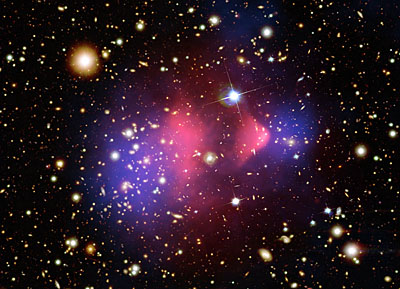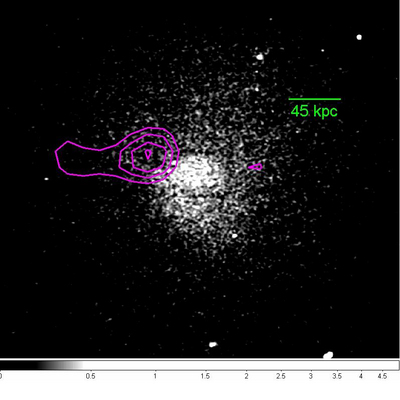Galaxy clusters are colliding faster than previously thought

Two satellites that image the sky in the X-ray field, recently studied one of the largest galaxy collisions in the universe, and gathered evidence that these clusters can collide and collapse much faster than astronomers had previously thought. The XMN-Newton and Chandra space telescopes captured a pair of galaxy clusters merging into a supercluster. The discovery adds to existing evidence that galaxy clusters can rapidly collapse into each other.
As individual galaxies merge and swirl into each other, they get rid of the hot gas that burns in strips out into space, essentially providing a seal for the existence of the violent event. However, detecting a collision between galaxy clusters is not easy. Rento Dufke and his colleagues at the University of Michigan in Ann Harbor used the two space probes to unravel the puzzle behind the enigmatic Abel 576 cluster.
The researchers discovered that there is a noticeable difference in the speed of the gas, one part of the cluster seems to collapse faster than the other parts. Fast moving gas is not a mystery, but this gas is very cold in astronomical terms - barely 50 million degrees Celsius. Gas moving at such speeds must have heated to at least double the temperature. To solve this mystery, the researchers realized that it's all a matter of point of view. We see Abel 576 from the front. From our perspective, one cluster is just behind the other cluster. The cold clouds of gas are the cores of any cluster that survived the initial collision, but will now fall back and merge again. Eventually, the whole system will become one big cloud.

But 576
The Bullet Cluster is a well-studied pair of galaxy clusters, and even the collision in it was facing us. One of the clusters passed through the other cluster, like a bullet passing through an apple. In the projectile cluster, this happened in our line of sight so we can see both clusters. Dorfe realized that Abel 576 is actually a pair of colliding clusters, which we see from the front and therefore one of the clusters is exactly behind the other. The "cold" clouds are the cores of each cluster, which survived the initial collision but will eventually merge. The data reveals that these clusters collided at a speed of over 3,300 kilometers per second. This is interesting because in some computer models of colliding galaxies it was difficult to reach such a high speed.
Nevertheless, the collision velocity of the projectile cluster is estimated to be similar to that of the Abel 576 system. "There is now a growing body of evidence that high collision velocities are possible," Dubka says. "The task of studying these velocities is now at the doorstep of cosmologists.
Collisions of this type between galaxy clusters are considered rare. In the collision, the inner gas is thrown out and out of equilibrium and if not detected it causes an underestimation of the mass of the clusters by 5 to 20 percent. This figure is important because the masses of galaxy clusters are used to estimate the cosmological parameters that describe how the universe expanded. Therefore, identifying systems that have undergone a collision is important to our understanding of the universe.
Dufka and his colleagues are studying a large number of clusters that have a high probability of being pairs of clusters colliding with each other.

8 תגובות
Due to the relative magnitudes of possibilities we can observe a magical universe on the one hand, and full of violent events on the other; We are in a location of relatively small size, and from time to time we are surprised by discoveries using the tools we have developed, and their ability to allow us to understand on a very small scale, in relation to what the tools do not recognize yet, and therefore we are still in the age of the unimaginable.
Only unique understanding abilities that go beyond the above tools, will bring us closer to understanding a universe much larger than we know.
According to my understanding, clusters that collide can be viewed in 3 situations = main stages:
1) in motion towards a collision ("converging" directions of motion)
2) In the middle of the collision. In this situation it is a supercluster (in this situation it is expected to see "opposite" directions of movement of different galaxies that make up the supercluster, each galaxy according to its source cluster, more or less)
3) In the movement of "separation" (directions of movement are "moving away")
Regarding the mutual velocity, here the expectation is that the closer the clusters are, then their relative velocity will be greater.
The relative speed peak should be in the supercluster state.
Father, do you have any information:
What is the situation with the 576 and the aforementioned "bullet" system?
Are there other colliding clusters known?
Is the situation similar in a collision between galaxies?
Thanks.
What happens to the stars in those colliding galaxies?? And when will it happen with us if at all?
Don't forget that this is volume, not area, so you have to multiply the area by the square or if the length by the third.
The size of a spiral galaxy is about thirty kiloparsec, according to the scale the whole thing is about one hundred kiloparsec if so what size of a cluster is it, then there can be a maximum of two or three galaxies in the drawing.
Something is not right here.
Sabdarmish Yehuda
Everything that happens in the universe conforms to Newton's laws and nothing
does not occur spontaneously
God forbid! What a mess ! Unbelievable at all!!!